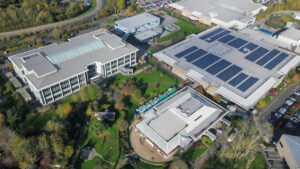Modern Architecture is more than just a design style – it was a profound shift in architectural thinking that emerged in the early 20th century. It emphasized function over formality, simplicity over excess, and the use of innovative materials and techniques instead of traditional ornamentation. In contrast to the ornate Victorian and Art Deco eras before it, the Modern movement stripped away unnecessary decoration and focused on how buildings work for their users.
For aspiring designers, understanding the core principles of Modern Architecture is critical. These principles – from the famous dictum “form follows function” to integrating buildings with their natural surroundings – serve as foundational guidelines for creating structures that are functional, efficient, and honest in design. Mastering these principles of modern architecture will equip emerging architects to design projects that meet contemporary needs while drawing on the legacy of the Modernist pioneers who redefined architecture around the world.
Table of Contents
Principle 1: Form Follows Function
One of the most fundamental tenets of Modern Architecture is form follows function. Popularized by Louis Sullivan in the late 19th century, this principle states that a building’s shape and design should be primarily based on its intended purpose. In practice, every element – from the floor plan to the facade – stems from its use. Modern architects start by planning spaces around their functions rather than imposing an arbitrary form and then fitting functions inside.
The result is architecture where functional needs drive design. For instance, a home adhering to this principle will arrange rooms according to daily activities (kitchen near dining, living areas oriented for light), instead of adding decorative spaces with no purpose. A factory or office built this way tends to have a straightforward layout that maximizes efficiency and workflow. The aesthetic appeal emerges from the logic and clarity of a design that perfectly suits its function.
Practical Implications of Form Follows Function:
-
Spaces are planned around their use (e.g., kitchens adjacent to dining for efficiency, living areas placed for natural light).
-
Building exteriors often mirror interior functions; for example, an auditorium might protrude outward to express the large seating space inside.
-
Any decoration grows organically from useful elements – structural bracings or vents might be left exposed and arranged neatly, adding visual interest while serving a purpose.
Principle 2: Emphasis on Volume Over Mass
Modern Architecture conceives buildings as volumes of space rather than heavy masses. Traditional structures relied on thick walls and weighty forms; modernists, by contrast, viewed a building as a composition of light, open spaces defined by slim elements. This gives modern structures a sense of lightness and openness, as if they are collections of interlocking volumes instead of solid blocks.
Advances in construction (steel frames, reinforced concrete) made this approach possible. Load-bearing walls were replaced by skeletal frames, so walls became non-structural “curtains” that could be opened up with glass or eliminated. As a result, modern buildings often appear visually lightweight – for example, a top floor may cantilever outward on thin columns (creating a floating volume) and large windows span across facades. The overall impression is volume and transparency taking precedence over solidity.
Features of Volume-Centric Design:
-
Open, flowing interiors: Fewer structural walls mean rooms can merge into one another, providing an expansive, continuous space.
-
Thin planar surfaces: Roofs and floors are thin flat planes (enabled by steel and concrete) that often extend outward (cantilevers), emphasizing a hovering, volumetric quality.
-
Extensive glazing: Generous windows, glass walls, or open courtyards break up any sense of mass, highlighting light-filled volume instead.

Principle 3: Minimal Ornamentation
A hallmark of Modern Architecture is minimal ornamentation, meaning little to no applied decoration. Modernist architects believed that a building’s form and materials should stand on their own without excessive adornment. Influential critics like Adolf Loos even argued that ornament was unnecessary and outdated (“ornament is a crime”). Thus, modern buildings tend to have clean lines and undecorated surfaces, deriving beauty from proportion and materials rather than added details.
In practice, facades are kept simple and geometric. There are no busy cornices or moldings as found in earlier styles – just plain surfaces (often white or the natural color of the material) and the pattern of structural or window elements. This gives modern structures a timeless, uncluttered look that emphasizes function. For designers, the lesson is restraint: every line or element must have a purpose, otherwise it can be eliminated.
Outcomes of Embracing Simplicity:
-
Clean, plain facades: Walls are smooth and unembellished, without ornate trim or historic detailing.
-
Emphasis on form and proportion: Visual interest comes from the building’s basic shape and the rhythm of openings, not from applied art.
-
Uncluttered interiors: Inside, fixtures and furnishings are kept streamlined. Ceilings, floors, and walls continue the simple aesthetic, creating a cohesive minimal environment.
Principle 4: Honesty of Materials
Modern Architecture champions honesty of materials – using building materials truthfully and celebrating their natural appearance. Instead of disguising materials or hiding structural elements, modernists let steel, concrete, glass, and wood show their true character. For example, if a structure is concrete, a modern design might leave it exposed rather than covering it with plaster to mimic stone. The philosophy is that each material has an inherent beauty and that authenticity gives a building integrity.
This approach leads to designs where you often see structure and materials plainly. Beams and columns might be left visible (rather than concealed behind false walls), revealing how the building stands up. Brick or concrete walls may be unpainted so their texture becomes part of the aesthetic. Glass is used generously to open up views and isn’t obscured by heavy frames or ornament. By being honest in material use, modern architecture creates an aesthetic of authenticity – what you see is genuinely what the building is made of and how it is built.
Examples of Material Honesty:
-
Exposed concrete and brick: Structural surfaces are left in their natural state – concrete walls might show the pattern of their formwork, and brickwork is visible with its true color and texture.
-
Visible frameworks: Steel or wood structural elements are not hidden. A design may proudly display a grid of columns and beams, which also adds a rhythmic visual pattern.
-
Natural finishes: Instead of paint or heavy polish, materials like wood receive minimal treatment (clear finish or raw) so the grain and tone are evident. Metals are often used in plain form (protected from rust but not covered up).

Principle 5: Open Floor Plans
Modern Architecture revolutionized interiors with open floor plans. Instead of many small enclosed rooms (typical in traditional buildings), modern designs minimize interior walls to create larger, multi-use spaces. This was made possible by structural advances – steel or concrete frames mean walls no longer must carry the building’s weight, so they can be omitted or placed flexibly. The result is a flowing interior where functions (living, dining, working, etc.) share open zones rather than being rigidly separated.
Open plans offer several advantages. They allow more natural light to penetrate and air to circulate because there are fewer barriers. Spaces can also adapt to different needs over time – for instance, an open office floor can be reconfigured as teams change, and an open living area in a house can accommodate gatherings or quiet family time equally well. This layout promotes social interaction by keeping people in a connected space. For designers, mastering open-plan design means defining areas through furniture arrangement, level changes, or partial dividers instead of full walls, and ensuring the openness remains comfortable and functional.
Benefits of Open Floor Plans:
-
Greater flexibility: Open layouts let spaces serve multiple purposes and be reconfigured easily (a living room might also include a work-from-home corner, for example).
-
More light and flow: With fewer walls, daylight reaches farther into the interior and movement is more free, giving even smaller buildings an airy, spacious feel.
-
Social connectivity: In homes, an open kitchen/living area keeps family members engaged with each other; in offices, open plans encourage communication and teamwork (with added quiet zones as needed for focus).
Principle 6: Integration with Nature
Modern Architecture often strives for a strong integration with nature. Instead of treating a building as an isolated object, modernists design structures to harmonize with their surroundings, maximize natural light and views, and bring the outdoors inside. This principle can be seen as a reaction against the dark, enclosed spaces of 19th-century buildings and also as an echo of earlier organic architecture movements. Frank Lloyd Wright’s philosophy of “organic architecture” exemplified this approach: his buildings (like Fallingwater, which is built over a waterfall) seem part of their environment. In general, modern designs blur the boundary between inside and outside.
In practice, integration with nature appears as large expanses of glass for views and sunlight, incorporation of gardens and courtyards, and orientations that respond to sun and wind. A modern house might have floor-to-ceiling glass walls facing a scenic view, or a public building might include an open-air atrium with plants. Roof gardens and broad overhangs further link the structure to nature, providing green space and climate control. By respecting natural context, modern architecture creates more harmonious, livable spaces. This principle also foreshadowed today’s sustainable design focus – the idea that buildings should work with, not against, their surroundings.
Ways Buildings Embrace Nature:
-
Extensive glazing: Panoramic windows, glass doors, and curtain walls invite natural scenery and daylight deep into interior spaces.
-
Indoor-outdoor living: Elements like patios, atriums, and roof gardens bring usable outdoor space into the design and let occupants enjoy nature as part of daily life.
-
Site-sensitive design: Buildings are oriented for optimal sun exposure and ventilation. Local materials (stone, wood, etc.) are often used to help the structure blend with its context and reduce environmental impact.
Principle 7: Use of New Technologies and Materials
A driving force behind Modern Architecture was the eager use of new technologies and materials. Modernists embraced innovations like structural steel, reinforced concrete, and mass-produced glass to design buildings in ways previously impossible. Early modernist works took advantage of these materials to create skyscrapers, wide-span roofs, and transparent glass facades that broke with past limitations. The mindset was that architecture should reflect the “machine age” – efficient, forward-looking, and unencumbered by old constraints.
For designers, this principle is about innovation. Modern architects pioneered prefabricated components, new structural systems (shells, cantilevers, cable structures), and integrated novel building services (electric lighting, elevators, air conditioning) into their designs. They were unafraid to experiment with construction techniques and forms. In the same spirit, today’s architects continue this tradition by using cutting-edge tools and materials – from computer modeling and sustainable tech to 3D-printed components. The essence remains: leverage the latest technology to improve how buildings are built and how they perform, making architecture more daring, efficient, and suited to contemporary needs.
Modern Technologies in Architecture:
-
Structural innovation: Modernism introduced steel-frame construction, thin concrete shells, and long-span trusses, enabling new building heights and forms (like skyscrapers and large open halls).
-
New materials: Architects began to use industrial materials such as plate glass, chrome steel, and even early plastics, incorporating them visibly into designs (e.g., all-glass curtain walls).
-
Industrial methods: Prefabrication and standardization of building parts became common to increase efficiency and precision – an approach continued today with modular construction and off-site fabrication.

Principle 8: Expression of Structure
Many modern buildings make the structure itself an expressive design feature. Instead of concealing beams, columns, and other supports behind finishes, Modern Architecture often exposes them and highlights them as part of the building’s visual identity. This principle is about celebrating engineering – the way a building stands is visibly integrated into its appearance.
In practice, expressing structure might mean leaving a steel or concrete frame visible on the facade or in the interior, turning it into an architectural feature. A famous later-modern example is the Centre Pompidou in Paris, which places its color-coded structural skeleton and mechanical systems on the exterior. Even simpler buildings might expose their roof trusses in a hall or use visible cross-bracing on a glass facade.
The result is an aesthetic of structural clarity – observers can literally see how the building is held up. For designers, this approach means planning the form and structure together so that beams and supports form an intentional pattern. When done well, the structural elements themselves provide rhythm and interest, removing the need for applied decoration.
Effects of Structural Expression:
-
Exposed framing: Columns, beams, and braces are left in sight, creating a grid or pattern that defines the facade or interior ceiling.
-
Structure as ornament: The shape of the building often directly reflects structural needs – an arch or bracing element isn’t hidden but becomes a defining visual feature.
-
Integrity in design: By making the support system apparent, a building gains a sense of honesty and integrity. The structure essentially becomes the ornament, proving that functional parts can also be beautiful.
Frequently Asked Questions
How are the principles of modern architecture different from those of traditional architecture?
Principles of Modern Architecture differ in several key ways from traditional architectural principles. Traditional architecture (for example, classical or Victorian styles) often emphasized decorative ornamentation, symmetry, and adherence to historical forms. Modern architecture, by contrast, prioritizes function, simplicity, and innovation. For instance, where a traditional design might include decorative columns and elaborate moldings, a modern design opts for clean lines and little to no decoration. Older buildings were typically divided into many small rooms, whereas modern architecture promotes open floor plans and fluid, connected spaces. Modernists also favored new materials like steel, concrete, and glass over heavy stone or brick, allowing building forms to be dictated by use and structure rather than by past styles.
What are some examples of buildings that embody the principles of modern architecture?
Many iconic structures showcase the principles of modern architecture. For example, Villa Savoye (1931, France, by Le Corbusier) is a white rectilinear villa with an open floor plan and no ornamentation. Seagram Building (1958, New York City, by Mies van der Rohe) is a sleek glass-and-steel skyscraper that epitomizes minimalist form and honest structural expression. Fallingwater (1939, Pennsylvania, by Frank Lloyd Wright) is a house built over a waterfall, seamlessly integrating with its natural surroundings. These designs all feature open, flowing spaces, clean geometric forms, visible structure, and an absence of superfluous decoration – hallmark traits of modernist principles in action.
Which architects are known for pioneering the principles of modern architecture?
Several architects are celebrated for pioneering the principles of modern architecture. Le Corbusier (Swiss-French) was a leading figure, advocating functional design, open plans, and new forms in projects like Villa Savoye. Ludwig Mies van der Rohe (German-American) championed the dictum “less is more,” using minimalistic glass-and-steel construction in works such as the Barcelona Pavilion and the Seagram Building. Frank Lloyd Wright (American), though an independent voice, influenced Modernism with his organic architecture – buildings like Fallingwater and his Usonian houses emphasized integration with nature and open interiors. Other pioneers such as Walter Gropius, Alvar Aalto, and Oscar Niemeyer also helped shape and spread modernist ideas globally through their innovative designs.
Is it true that the principles of modern architecture are still relevant today?
Yes – the principles of modern architecture are still very relevant today. Most contemporary designs borrow from modernist ideas like open layouts, functional forms, and clean aesthetics. In fact, many sustainable and minimalist trends echo modern principles: for example, using simple geometric shapes, exposing structural elements or materials for honesty, and integrating buildings with natural light and surroundings for efficiency. While architects today consider new factors (such as energy performance and cultural context), they still rely on the modernist foundation. Concepts like “form follows function,” simplicity in design, and truth to materials remain cornerstones of architectural practice. Modern architecture’s principles continue to guide the creation of buildings that are practical, innovative, and timeless.
Conclusion
Modern Architecture fundamentally changed the way buildings are designed, and its guiding principles continue to influence architects today. For an aspiring designer, the eight principles of modern architecture discussed above serve as enduring lessons – emphasizing function, honesty, simplicity, innovation, and harmony with the environment. Mastering these concepts helps one create designs that are both practical and inspired. Even as new styles and technologies emerge, the core ideas of Modernism (like form following function and truth to materials) remain essential tools in an architect’s toolkit. By applying these principles, designers can craft buildings that meet present-day needs while standing the test of time – architecture that is useful, visually clean, and true to its purpose.
Resources:
-
Royal Institute of British Architects (RIBA). (2018). What is Modern Architecture?
-
ThoughtCo. Craven, Jackie. (2024). Architecture Timeline – Western Influences on Building Design.
-
Rethinking The Future. (2021). Past, Present and Future: Modern Architecture.
-
Encyclopædia Britannica. (n.d.). International Style.
For all the pictures: Freepik
Suggested article for reading:
4 Key Applications of Fire Detection Sensors Across the Construction Industry
Top 5 Types of Fire Detection Sensors for 2025: Enhancing Safety with Smart Technology
6 Smart Ways to Integrate Biophilic Design into Sustainable Homes
7 Iconic Modern Architecture Projects That Redefined Urban Landscape
8 Reasons Why Concrete Sensors Are Essential for Modern Construction



